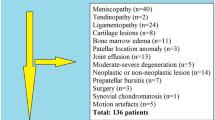Abstract
Purpose
To investigate whether the universally accepted range of normal patellar height ratios derived from radiography for the Insall–Salvati (IS) and Blackburne–Peel (BP) methods could be similarly applied to both CT and MRI.
Materials and methods
Institutional review board approval was obtained with waiver of informed consent for this HIPPA-compliant study. A total of 45 knees in 42 patients (15 men, 27 women; age range 11 to 75 years, mean age 39 ± 20 years) who underwent tri-modality (radiograph, CT, and MRI) examinations were selected. All patients had knee imaging obtained for a variety of reasons and measurements were performed by two independent readers who were blinded to each other’s measurements or the respective measurements derived from each of the methods. Paired t test was used to compare the mean values among the modalities. Inter-observer and inter-method agreements were assessed using intra-class correlation coefficients.
Results
Statistically significant, but small quantitative differences are noted between tri-modality patellar height ratios. For comparable results, the small addition of 0.13 and 0.10 are needed for the Insall–Salvati measurements on MRI and CT respectively, compared with radiographs. For the Blackburne–Peel ratio, an additional adjustment of 0.09 is needed between radiographs and MRI, but not between radiographs and CT. These adjustments are independent of gender. The interobserver reproducibility was excellent (ICC ≥ 0.94) for both the Insall–Salvati and Blackburne–Peel methods for all modalities.
Conclusion
The results indicate that cut-off values for patella alta and baja derived from radiographs should not be directly transposed to CT and MRI; however, the adjustments are relatively minor. These measurements show excellent reproducibility for all modalities currently used for patellar height measurements.


Similar content being viewed by others
References
Ward SR, Terk MR, Powers CM. Patella alta: association with patellofemoral alignment and changes in contact area during weight-bearing. J Bone Joint Surg Am. 2007;89:1749–55.
Park MS, Chung CY, Lee KM, Lee SH, Choi IH. Which is the best method to determine the patellar height in children and adolescents? Clin Orthop Relat Res. 2010;468:1344–51.
Neyret P, Robinson AH, Le Coultre B, Lapra C, Chambat P. Patellar tendon length—the factor in patellar instability? Knee. 2002;9:3–6.
Diederichs G, Issever AS, Scheffler S. MR imaging of patellar instability: injury patterns and assessment of risk factors. Radiographics. 2010;30:961–81.
Phillips CL, Silver DA, Schranz PJ, Mandalia V. The measurement of patellar height: a review of the methods of imaging. J Bone Joint Surg Br. 2010;92:1045–53.
Shabshin N, Schweitzer ME, Morrison WB, Parker L. MRI criteria for patella alta and baja. Skeletal Radiol. 2004;33:445–50.
Shrout PE, Fleiss JL. Intraclass correlations: uses in assessing rater reliability. Psychol Bull. 1979;86:420–8.
Miller TT, Staron RB, Feldman F. Patellar height on sagittal MR imaging of the knee. AJR Am J Roentgenol. 1996;167:339–41.
Seil R, Muller B, Georg T, Kohn D, Rupp S. Reliability and interobserver variability in radiological patellar height ratios. Knee Surg Sports Traumatol Arthrosc. 2000;8:231–6.
Smith TO, Davies L, Toms AP, Hing CB, Donell ST. The reliability and validity of radiological assessment for patellar instability. A systematic review and meta-analysis. Skeletal Radiol. 2011;40:399–414.
Rogers BA, Thornton-Bott P, Cannon SR, Briggs TW. Interobserver variation in the measurement of patellar height after total knee arthroplasty. J Bone Joint Surg Br. 2006;88:484–8.
Berg EE, Mason SL, Lucas MJ. Patellar height ratios. A comparison of four measurement methods. Am J Sports Med. 1996;24:218–21.
Ali SA, Helmer R, Terk MR. Patella alta: lack of correlation between patellotrochlear cartilage congruence and commonly used patellar height ratios. AJR Am J Roentgenol. 2009;193:1361–6.
Miura H, Kawamura H, Nagamine R, Urabe K, Iwamoto Y. Is patellar height really lower after high tibial osteotomy? Fukuoka Igaku Zasshi. 1997;88:261–6.
Reider B, Marshall JL, Koslin B, Ring B, Girgis FG. The anterior aspect of the knee joint. J Bone Joint Surg Am. 1981;63:351–6.
Author information
Authors and Affiliations
Corresponding author
Rights and permissions
About this article
Cite this article
Lee, P.P., Chalian, M., Carrino, J.A. et al. Multimodality correlations of patellar height measurement on X-ray, CT, and MRI. Skeletal Radiol 41, 1309–1314 (2012). https://doi.org/10.1007/s00256-012-1396-3
Received:
Revised:
Accepted:
Published:
Issue Date:
DOI: https://doi.org/10.1007/s00256-012-1396-3




